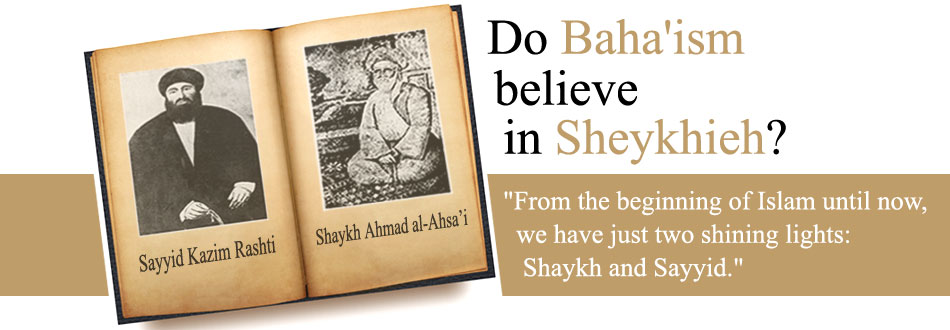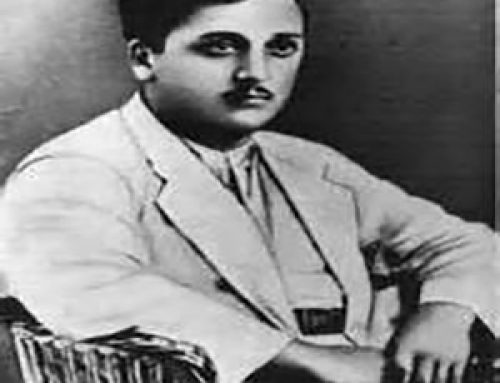

Shi’a Muslims believe 12 Imams (leaders) after Prophet Muhammad (pbuh) whom the last one, is Imam Mahdi (pbuh) the son of Imam Askari (pbuh). Imam Mahdi had a minor occultation((Gheybat-e Soghra (غیبت صغری) )). In this period, he had four special deputies. Before the death of the fourth representative, Imam Mahdi in a letter wrote to him:
“You will die in six day. Do not will to anyone and anyone who claims to have relation with me is a liar and his claim is false((For more information refer to the article The Last Leader.)).”
During the period of 1157 A.H to 1242 A.H Shaykh Ahmad al-Ahsa’i as a Muslim Shi’a claimed that between the people and Imam Mahdi (pbuh) there should be some great and pious persons who he called them ‘Rokn-e Rabe Imam’ (fourth pillar of the faith). He taught some students in Karbala and in his speeches he introduced himself as one of the four pillars. This belief of Ahsa’i was heresy in Shi’a, and heresy is forbidden. Ahsa’i appointed his most talented student Sayyid Kazim Rashti as his successor.


Sayyid Kazim Rashti
Rashti was a man of unknown origin. At that time people of Rasht (a city in northern Iran) disclaimed any knowledge of his birth and upbringing. Rashti developed Ahsa’i’s false claim regarding the fourth pillar which he called him the Báb((The Gate)) of 12th Shi’a Imam. He started to look for such person to bestow the title of Báb in order to achieve through him all his aims. Following in his master’s footsteps, Sayyid Kazim Rashti answered every questions people asked even if his answers were simply wrong! Thus he was able to lure some shaken beliefs and deviated inclinations, who became his disciples.
The most prominent of these disciples was a man named Mulla Hussain Boshru’i from Bushruyeh, a village in Khurasan in north eastern Iran. Boshru’i was a man known for slyness, shrewdness, craftiness and caprice. He started to promote his beliefs to attract people, among them was Umm Salama, daughter of Salih Qazwini. She was married in her early youth to her cousin, but deserted her mutual life. She then started to correspond with Sayyid Kazim Rashti who was quite prolific in response, because she was just suitable for his ends. Sayyid Kazim Rashti called her in his letters Qurrat al-‘Ayn((Delight of the eye)) and he invited her later to Karbala; however, Rashti died in 1259 A.H before her arrival.
In Karbala, she was received by Boshru’i and the rest of Rashti’s disciples. She became the most zealous of them and when she publicly put her call to practice with some of Rashti’s students, they called her Táhirih((The chaste)).

Bábism
Among the disciples of Rashti there was a man called `Ali Muhammad Shirázi. He was born in Shiraz in 1235 A.H (1819 A.D). His father died while he was young and his uncle, who took him under his guardianship, put him in one of Rashti’s disciple’s class called Maktab Abed. After a while his uncle took him to the port of Bushehr on the Persian Gulf, where he opened a commercial store for him, but due to his mental disorder he could not manage the store and his uncle sent him to Karbala at the age of 20 for rehabilitation. Rashti recognized him as his disciple.
In his classes Rashti always told the students that they should look for the Báb of Imam Mahdi. After his death the disciples decided to look for the Báb throughout Iran and `Ali Muhammad Shirázi moved to Shiraz, whereupon Hussain Boshru’i appointed Qurrat al-‘Ayn instead of Rashti to teach the disciples in Karbala. Boshru’i then went to Shiraz and joined `Ali Muhammad Shirázi where he could exploit the young man’s naiveté and conceit. He suggested him that he would soon be a man of great importance whom his master Rashti had informedand that he might be the Báb. Boshru’i even offered himself to be Bábu’l-Báb((Gate of the Gate)), and continued to persuade Shirázi until on Jamadi-ul-Awwal 5, 1260 A.H (May 23, 1844), the 25-years-old Shirázi announced that he is the Báb. During this announcement four other disciples of Rashti, such as Mirza Shafee Tabrizi announced themselves to be the Báb, but they were not successful.

Hussain Boshru’i hurried to announce the manifestation of the Báb((Zuhur al-Báb)) to the rest of Rashti’s disciples, announcing to some that he was also is the Bábu’l-Báb. It was later revealed that one of the moving figures behind the faction was the Russian embassy in Tehran; the man in charge ostensibly accepted Islam, studied Arabic, Persian, and became a regular attendant of Rashti’s lectures. In fact he was implanting the misleading tree in the land of Islamic nation. He played an effective role in managing Sayyid Kazim Rashti, `Ali Muhammad Shirázi and Husayn-Ali Núri (Bahá’u’lláh). To study more you can refer to The Memoirs of Count Dolgorukov.
As mentioned above, through the enticement of Hussain Boshru’i and the machination of Russian spy, Kenyaz Dolgorukov, `Ali Muhammad Shirázi, declared that he was the Báb to the awaited Imam Mahdi on Jamadi-ul-Awwal 5, 1260 A.H. Boshru’i started to tell people that he had seen the Báb with his own eyes and called them to follow him, those who followed him were called Bábis. When the number of Bábis reach to nineteen, Shirázi called them Hurúf-i-Hayy((Letters of the Living)). Then he decided to divide the year into nineteen months, each month includes 19 days. He designated the day which .
he announced his claim Jamadi-ul-Awwal 5, 1260 A.H as the beginning of this calendar. The governor of Shiraz ordered to arrest Báb for his false claims. Once being slapped his face, Báb desisted from his initial claim and told the governor that he is not the gate (Báb) of Imam Mahdi((Dawnbreakers, Pages 137-141)).
End of Part One.





Leave A Comment
You must be logged in to post a comment.